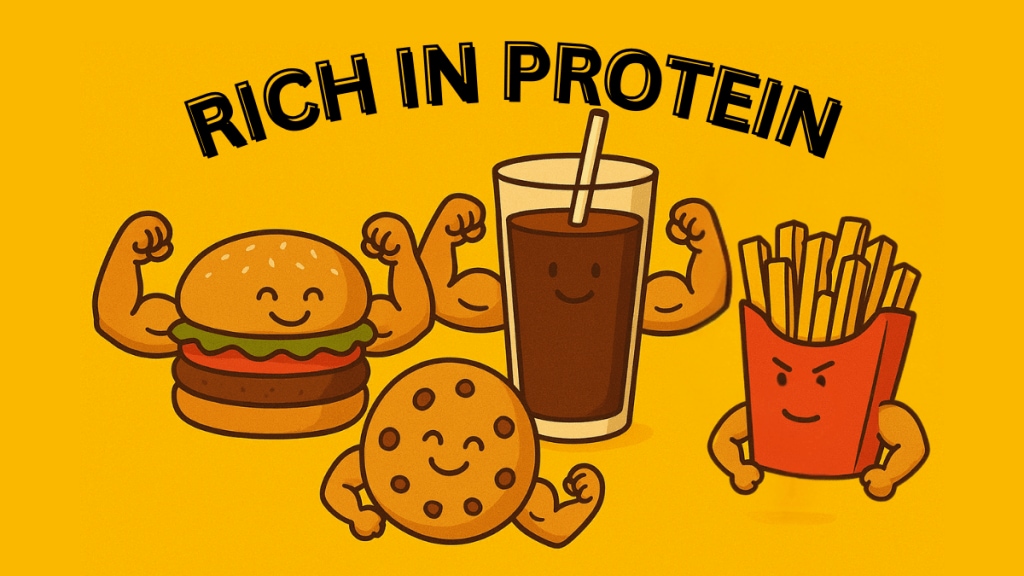In 2025, the global fast-food industry has found its new golden ingredient, not cheese, not spice, but protein. From burgers and cookies to cold brews and kulfi, brands pitch protein as the magic bullet for satiety, muscle gain and weight management. But does sprinkling protein into fast food actually make meals healthier, or is this just clever marketing with a halo effect?
McDonald’s India is leading this charge with the launch of its “Protein Plus Slice,” a 100% vegetarian soy-and-pea-based topping developed with the government-backed CSIR-CFTRI. Each slice adds 5 grams of protein, and customers can stack up to three slices in a burger. The rollout created frenzy: the chain sold over 32,000 slices in just 24 hours, translating into 160,000 grams of added protein across West and South India.
“At McDonald’s India (W&S), we have always believed in mindful indulgence with our Real Food Real Good promise, which began seven years ago. The launch of ‘Protein Plus Slice’ represents one such significant milestone in our Real Food Real Good journey. This industry-first innovation was inspired by consumer insights showing growing interest in protein… Our Protein Plus Slice is an authentic product made with plant-based protein-rich ingredients for all our customers who are seeking protein enhancements in their everyday meals”. McDonald’s spokesperson told financialexpress.com
The slice is promoted through chef Sanjeev Kapoor, fitness influencers, and a campaign positioning McDonald’s as the brand that takes your “extra dose of protein” seriously. For India, where protein deficiency affects nearly 80% of households, this is also pitched as a social intervention.
It’s not just McDonald’s. Dairy major Amul has rolled out protein-fortified buttermilk, lassi, and kulfi. Startups like SuperYou sell protein chips. Globally, chains from Shake Shack to Chipotle are explicitly marketing “high-protein” options, while Starbucks is about to launch a protein cold foam (15 grams per serving) to pair with its existing “Protein Boxes.”
The numbers back the frenzy. A Cargill survey found 61% of consumers increased their protein intake in 2024, up from 48% five years ago. According to Grand View Research, the protein-fortified food products market is projected to hit $101.6 billion by 2030. “Protein is no longer limited to gym-goers. It’s become a mainstream expectation,” a Mintel analyst told CNBC.
The health halo problem
Nutritionists, however, sound a note of caution. These products may come with downsides: added sugars, high sodium, artificial flavours or preservatives, and lower fibre compared to whole foods. Processing can also influence satiety and long-term dietary quality.
McDonald’s McSpicy Paneer with protein slices, for instance, still packs over 700 calories. Panda Express pushes plates with 41 grams of protein, but they come drenched in sauces heavy in sugar and sodium.
“If it’s processed, it isn’t the best, even when it’s high in protein. Protein isn’t the sole determinant of health. These products may come with downsides: added sugars, high sodium, artificial flavours or preservatives, and lower fibre compared to whole foods,” Diksha Chhabra, a health coach and nutritionist, told financialexpress.com.
She advises consumers to ask: What’s the protein source? How much protein per serving? What else is in the ingredient list?
More than health, it’s strategy
For QSRs, protein isn’t just a nutrient; it’s a revenue strategy. “Younger consumers are willing to pay more for perceived health benefits,” notes Mintel. That makes protein a convenient value-add in a market where price wars and promotions have eroded margins.
But there are risks. Whey protein isolate prices rose 25% year-on-year, according to Vesper Tool, pushing companies to explore plant-based or blended alternatives. Taste, cost and supply chain resilience will decide whether protein innovation is sustainable.
Protein fortification is undeniably changing the way fast food is marketed. It offers satiety, aligns with modern fitness goals, and makes brands appear responsive to health-conscious consumers. But nutritionists warn: unless chains also cut calories, sodium and fat, these meals remain indulgences dressed up with a “protein halo.”
At the end of the day, the knife doesn’t hover on how much protein these fast food chains can add; it is whether this protein push is less of a revolution and more of a rebranding.

